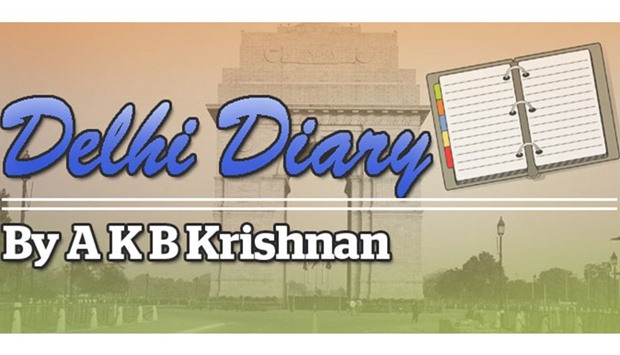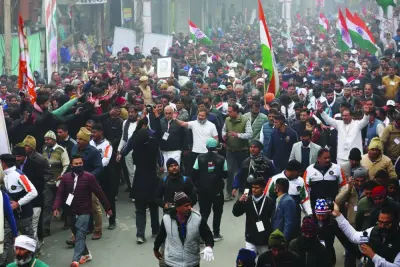“Mr Modi is the prime minister of India. He is my prime minister as much as yours. It is his privilege if he decides to criticise or ridicule me, my family or my party while addressing public gatherings outside India. He may be used to such culture, but I am not. I shall not criticise or ridicule my prime minister or his party on foreign soil.”
More than 65% of Indians are below the age of 35. And close to 50% of those are reasonably educated. So they would understand perspective logic. As for the senior citizens, condescension is easily discerned and never approved.
So, if the Congress Party vice-president and its chosen one for the prime minister’s chair, Rahul Gandhi, during the course of his interaction with students and professors of the University of California at Berkeley last week had told the Indian moderator something along the lines mentioned in the opening paragraph here, the majority of Indians would have applauded him. I say ‘majority’ because there will always be two opinions on anything political in India, so the saffron brigade would have looked for, and found, something else to beat Gandhi with.
As it was, Gandhi never troubled much of India with any such lofty magnanimity. He accused Modi of promoting divisive politics, creating space of terrorism in Kashmir by joining hands with the People’s Democratic Party (PDP) and ruining the economy through demonetisation and an “ill-thought-out” goods and services tax (GST). His audience must have been quite well-versed in this litany of charges as every Congressman worth his salt has been repeating these ad nauseam.
“Hatred, anger and violence and the politics of polarisation has raised its ugly head in India today…liberal journalists being shot, people being lynched because they are Dalits, Muslims, killed on suspicion of eating beef…this damages India very badly,” Gandhi told his audience.
Yes, all this is true. But journalists have been shot and killed earlier too. Minorities of various hues had suffered under the Congress rule as well. Lynching had taken place in several states before. These are home truths and there is no escaping from them. But painting such an inglorious picture of his country abroad does not sit well on the top leader of the main opposition party. If eventually Gandhi becomes prime minister – according to economist and senior Bharatiya Janata Party politician Subramanian Swamy there are apparently constitutional provisions that will prevent him from getting that post but that’s beside the point here – he will have to go back to the same audience and say ‘normalcy has been restored’ in India.
Be that as it may, Rahul was not all bluster and bully at UCB. He was very frank in admitting that his oratorical skills were not a patch on Modi’s. “He (Modi) is a very good communicator. Probably much better than me. He understands how to give a message to three or four different groups in a crowd. So his messaging ability is very subtle and very effective,” Gandhi told the university audience.
Going further he also admitted that the vision of the Congress-led United Progressive Alliance (UPA) government had a “sell-by-date” of 10 years but it had already stopped working by 2010, the year after the alliance returned to power. Reports reaching here don’t say if anyone in the audience asked why, and if it had stopped working, did he do anything in the next four years to revive that vision. Those were the four years when the Manmohan Singh government went down the bottomless pit of corruption and the Congress lost nearly everything it had worked for over the past six decades. Strangely, Rahul Gandhi was seen and heard defending the government at every turn. We are all blessed with wisdom in hindsight but those who aspire to lead nations must be endowed with the ability to look into the future, in a manner of speaking.
Rahul’s interaction with academia was going reasonably well. His prepared speech, which he delivered before fielding questions from the moderator and the audience, dwelt mainly on India’s achievements in various fields and its cultural diversity and the attendant dividends. Then, as if he had gone a little too far, he began listing the negatives. Everything came unstuck when he was asked about dynastic politics in India and how he, as a member of the Gandhi dynasty, viewed it. “Don’t get after me because that’s how the entire country is running,” said Rahul. Naturally, his being a Gandhi is no fault of his. But the sense of entitlement that is seen to be part of a dynasty is what Indians have come to loathe.
It would have been nice had Rahul stopped at that. But he seemed to sense that the audience enjoyed what he was saying and so wanted to explain further. And then he slipped and fell on his face!
“Most parties have that problem (of dynasties). So don’t give us the stick. Akhilesh Yadav (of Uttar Pradesh) is a dynast. Stalin (of Tamil Nadu’s DMK) is a dynast…Even Abhishek Bachchan is a dynast.” Seriously? Not content with that Gandhi went to say: “By the way, last I recall, Ambani’s kids were running their business and that was also going on in Infosys.” Now you know why there are so many videos and cameos about “Rahul Baba” and “Papu”. Surely the vice-president and soon-to-be-president of Indian’s grand old party must know the difference between public life and private enterprise. Unless, of course, he thinks that public life in the Congress Party is a private enterprise! And Infosys? How do you want to interpret that one?
Rahul was asked if he was ready to accept the challenges of the high office he is aspiring to occupy. “Yes, I am ready,” he said. But the more important question could be: Are Indians ready to accept the challenge of having Rahul Gandhi as their prime minister?
Modi’s AIADMK strategy may boomerang
The death of Jayalalithaa, ‘Amma-turned-eternal-general-secretary’ of All India Anna Dravida Munnetra Kazhagam (AIADMK) last December, had predictably opened the proverbial can of worms within that party even as it plunged Tamil Nadu into a period of political and administrative uncertainty.
The party has gone through many emotional and structural highs and lows since then and is now faced with the most defining and existential question in its 45-year life. The post-Jayalalithaa era has seen the incarceration of the self-appointed heir to her throne, Sasikala, on charges of corruption and a tug-of-war for power between three different factions. Naturally, the mountains of money that the party had amassed through Jayalalithaa were at the centre of the tussle.
Now, two of the factions, respectively led by incumbent Chief Minister Edapadi Palaniswami (EPS)and Ottakara Paneerselvam (OPS) have come together to put an end to Sasikala’s desperate bid to hang on to the party even from behind bars. In the normal course nobody would shed a tear for Sasikala who, as head of the so-called ‘Mannargudi Mafia’ that had had a vice grip on everything that Jayalalithaa did for nearly two decades, was one of the most hated persons in one of India’s richest states. If anything, Sasikala should never be allowed to come anywhere near the power structure in the state.
But then the way the EPS-OPS duo went about getting what they wanted has also left a bitter taste in mouths of not just the people of Tamil Nadu but of the whole nation. The expulsion by Assembly Speaker P Dhanapal of 18 ‘rebel’ AIADMK legislators just two days before the madras High Court was to decide on their petition seeking a floor test smacked of gross injustice and sheer desperation. It is quite likely that the expulsion would not pass legal scrutiny.
The role of Governor Vidyasagar Rao, and by extension that of the Narendra Modi government, in providing a long rope to EPS-OPS also goes against the grain of democratic norms. Modi, who swears by equitability and democracy for 1.25bn Indians at every opportunity he gets, seems to have conveniently put aside such higher ideals for the time being.

Delhi diary


